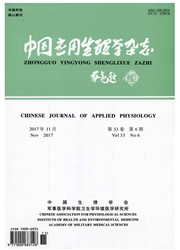

 中文摘要:
中文摘要:
目的:应用离体淋巴管灌流技术,观察失血性休克(HS)发展进程中淋巴管对P物质(SP)的反应性。方法:Wistar雄性大鼠随机分为对照组(仅麻醉与手术)和HS组(通过股静脉放血至平均动脉血压为40 mmHg,复制HS模型,分为休克0h、0.5 h、1 h、2h、3 h五个亚组)。各组在相应时间点分离胸导管,制备淋巴管,3 cmH2O跨壁压下行离体灌流,分别给予从低到高浓度的SP,测量淋巴管收缩末期口径、舒张末期口径、收缩频率(CF)和被动管径,计算收缩幅度(CA)、泵流分数(FPF)和紧张指数(TI),以给予SP前后淋巴管的CF、TI、CA、FPF的差值△CF、△TI、△CA、△FPF作为评价淋巴管对SP反应性的指标。结果:Shock 0 h与shock 0.5 h大鼠淋巴管对多个或一个SP浓度的△CF、△TI、△CA、△FPF显著高于对照组,shock 2 h淋巴管对SP的△CF(3×10-7mol/L)、△TI(1×10-7mol/L)以及shock 3 h淋巴管对SP的△CF(1×10-7mol/L、3×10-7mol/L)、△TI(1×10-7mol/L)、△CA(1×10-7mol/L)均显著低于对照组。结论:休克淋巴管对SP反应性呈双相变化,即早期升高,晚期降低。
 英文摘要:
英文摘要:
Objective: To observe the change of lymphatic reactivity to substance P(SP) during the process of hemorrhagic shock(HS) with a technique of lymphatic perfusion in vitro in this study.Methods: Male Wistar rats were randomly divided into control group(surgical procedure only) and HS group(the rats in this group were further divided into five subgroups: shcok 0 h,0.5 h,1 h,2 h and 3 h groups after duplicating the HS model with method of bloodletting to mean arterial blood pressure was 40 mmHg through the femoral venous).Thoracic ducts were separated from HS rats at the corresponding time points in each group.A segment of thoracic duct was pressed and perfused in vitro at transmural pressure of 3 cm H2O,and then stimulated with gradient SP respectively.The end systolic diameter,end diastolic diameter,contraction frequency(CF) and passive diameter of isolated lymphatics were measured,while the contraction amplitude(CA),tonic index(TI) and fractional pump flow(FPF) were calculated,and the different values between pre-and post-administration of SP of CF,CA,TI and FPF were calculated and expressed as △CF,△TI,△CA and △FPF to further assess the reactivity of lymphatics.Results: After SP incubation,the △CF,△TI,△CA and △FPF of 0 h-and 0.5 h shocked lymphatics were significantly increased when compared with that of control group on one or several concentrations.The △CF(at 3×10-7 mol/L of SP) and △TI(1×10-7 mol/L) of 2 h-shocked lymphatics and the △CF(1×10-7 mol/L,3×10-7 mol/L),△TI(1×10-7 mol/L) and △CA(1×10-7 mol/L) of 3 h-shocked lymphatics were all significantly reduced when compared with control group.Conclusion: The reactivity of lymphatics to SP presented a biphasic change during the process of HS: increase in early phase and decline in later stage.
 同期刊论文项目
同期刊论文项目
 同项目期刊论文
同项目期刊论文
 Influence of mesenteric lymph reperfusion on neurotransmitter expression in brain tissue of a superi
Influence of mesenteric lymph reperfusion on neurotransmitter expression in brain tissue of a superi 期刊信息
期刊信息
